
9 Mistakes Dog Trainers Say You’re Making
You don’t know what you don’t know. And for many dog owners, it’s the little things they don’t know that lead to headaches down the line.
“I always say, know better, do better,” says Deb Saperstein, owner of D’Tails Dog Training in Garwood, New Jersey, quoting Maya Angelou.
Dog training, whether you work with a professional trainer like Saperstein or attempt to take it on yourself is ultimately about forming good habits. But to do that you need to recognize the small — or big — mistakes you’re making. Many are insignificant in the moment, but over time compound into big problems you weren’t expecting.
Keeping It Pawsome spoke to Saperstein to see what are some of the most common mistakes dog owners make. Here are her top nine.
1. Saying No
Saying no to your dog can be pointless, Saperstein says; over time it simply becomes white noise to the dog.
“People who say no ultimately have to say it louder, stronger and more often. And all you’re doing is constantly reacting to something that’s wrong.”
It’s much better to acknowledge the good your dog does.
“The more good you acknowledge, the more good you will get,” says Saperstein. In general, dogs like to please their humans, and if acknowledged for doing something, they will continue that behavior. Yelling no at your pup is a form of acknowledgment, that for many dogs, will result in the opposite of what you’re trying to achieve.
Most people do a great job of this with puppies. Every time a puppy does something right, people praise it: “good dog,” “good puppy,” “nice job!” But as dogs get older many owners stop praising the good, essentially taking it for granted, and more often only reacting to the bad.
Take barking at a window, Saperstein says. Dogs bark at the window for lots of reasons: someone’s walking by the house, they see a squirrel, or a truck passes. Most people respond by yelling “quit it” or “shut up” across the room.
“Now you’re just barking with the dog. He’s saying there’s a violation out there, come and see.”
But rather than go see, you bark along with him. You think you’re telling him to be quiet, he thinks you’re confirming his suspicions.
Use Treats to Encourage Good Behavior
The best thing you can do, is walk over, look out the window, tell him there’s nothing to be worried about, and then take him away from the window.
“Everything good happens away from the window. So, I’m not going to give the dog a treat because he walked away from the window. But once we step away, further into the room, I’ll ask him to do something he does well (sit, down, paw) and then reward him for that behavior.”
The aim is to increase the time between when you’ve acknowledged whatever is outside the window, worked with him away from the window, and finally given him the treat. If your dog begins to stay relaxed when there’s something going on outside, you should acknowledge that behavior with praise.
If you use chew toys as a reward, be sure to check out our article on chew toy safety.
2. No Non-Socialized Dogs or Puppies Under 6 Months at the Dog Park

Dogs parks are an easy place to spot mistakes, Saperstein says. But the most common is people bringing in their unsocialized dog, thinking the dog park would be a great place to start with socialization.
“That’s not a good idea,” she says. “A beautiful Saturday afternoon with a full dog park is not the best move for a dog that has never been around other dogs.”
There’s no way to know ahead of time how that dog will respond to other dogs that want to play. Will he posture and try to be dominant? Will she bark because she’s scared, triggering something in another dog?
Oftentimes, the unsocialized dog is a puppy, but puppies should be at least 6 months old — and socialized — before visiting a dog park. Younger puppies might be too in the face of the older dogs or might get too scared.
“A puppy against multiple adult dogs… you’re putting yourself in a position where your puppy can get injured,” Saperstein warns.
If you’ve never been to a dog park before and want to give it a try, your best bet is mid-week or early morning. You’ll find there are fewer dogs and those there are regulars. The owners will have a good feel for the personalities of all the dogs and be able to tell you who to watch out for.
3. Waiting Too Long to Socialize Your Puppy
Generally speaking, Saperstein says, the sweet spot for socialization for a dog is between 8 and 16 weeks of age. (This does not mean you can’t socialize an older dog; it just might take more time.)
Saperstein acknowledges some veterinarians tell dog parents to keep their puppies at home until they’ve had they’re final shots — which doesn’t happen until 16 weeks.
But, she advises, double check. Many vets agree it’s safe to start socializing a puppy after the second round of vaccines. Only do so with fully vaccinated puppies and adult dogs, or puppies that are on the same vaccination schedule (ie, have had their second booster).
Small puppy play dates at your home or in your yard are the safest way to start with socializing. After the second round of boosters, you should be able to walk your pup around your neighborhood. Even if you’re not introducing him to other dogs yet, he’ll get to see them.
And remember, two puppies growing up together are not socialized just because they’ve learned to play with each other. They still have to be introduced to dogs of different sizes, breeds and age groups.

4. Forgetting to Ask Before Letting Dogs Mingle, Especially if You Have a Puppy
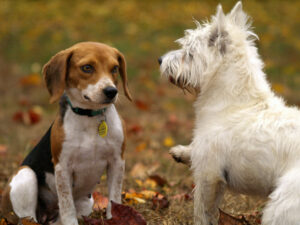
Once you’re ready to let your pup meet other dogs, make sure to follow meeting etiquette. First and foremost, always ask the other dog’s owner: “Is your dog dog-friendly?” If you have a puppy and encounter someone with an older dog, ask: “Is your dog puppy-friendly?”
It’s not the same thing, Saperstein says. A dog that likes other dogs may be overwhelmed by the exuberance of a puppy.
“Puppies can be really sweet but they can also be right in your face. They don’t have any social grace yet… It’s not automatic that all adult dogs like puppies.”
Puppies might jump up and try to put their paws on the other dog. They don’t mean anything by it, but lots of dogs don’t want to be jumped on.
Owners with adult dogs also shouldn’t forgo asking first, before allowing their dog to meet a dog it’s unfamiliar with.
“You need to respect the fact that not every dog wants to meet every dog,” Saperstein says. You should never try to force your dog to meet a dog (or a person) he doesn’t want to meet.
Leashes Can Heighten Discomfort
This is particularly important when your dog is on a leash. When he can’t get away from the situation that you’re trying to force him into, that’s when things can get ugly. An uncomfortable dog on a leash may have his fight or flight response triggered, causing him to react out of fear or frustration.
If you’re the one with the uncomfortable dog, don’t be afraid to say, “He’s not in the mood right now.” Or “He must be having a bad day,” and take him away from the person or dog he’s unhappy about.
Another option is to suggest walking together as opposed to standing still. Let the dogs walk side by side, or at each owner’s side, if one or both of the dogs is not fully comfortable interacting. You can continue your conversation and the dogs aren’t forced to wait and possibly get agitated.
Just don’t let them sniff the same things. If they encounter a piece of food, for instance, you don’t want them competing for who gets it.
5. Not Keeping a Close Eye on Your Dog
Perhaps one of the most common things Saperstein says she sees is dog parents becoming complacent about their dogs’ behavior.
You should never stop paying attention to your dog. Not when you’re walking him, not when he’s meeting other dogs, and not when there are other people petting him. No one knows your dog like you. You’re the best person to spot signs of discomfort that can lead to a growl or possible bite.
This is doubly true when your dog is on a leash, as that can create (once again) a fight or flight response.
Saperstein recounted one of the worst encounters she ever witnessed. Two men on a street, each with a dog, chatting. They did not let the dogs physically interact with each other, at least not at first. But at some point, someone must have thought it was okay. It wasn’t two seconds before one of the dogs had crunched down on the other’s nose. And Saperstein said saw it coming from across the street.
“The whole time, the mixed breed was staring and still; he was focused [on the other dog].”
(While Saperstein has let dog owners know when she’s seen something worrying, often, they didn’t appreciate her “butting in.” Because of this, she is more circumspect about intervening.)
Had the man with the mixed breed paid closer attention to his dog, he would have seen his dog was ready to attack. Instead, he was focused on the conversation.
“That’s where people make the biggest mistake,” Saperstein says. “They stand and chat and then they forget about the dogs or they’re not paying attention.” Even if the dogs have met before, you need to keep an eye on them.
The dogs might be fine for 10 minutes, but then one does something the other dog doesn’t like. If you’re not watching your dog’s demeanor, you’re going to miss the change in attitude and that’s when problems occur.
6. Don’t Forget People, Noises & Objects
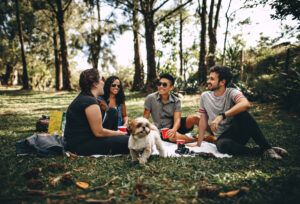
Socializing your dog includes more than just teaching him how to interact with other dogs. He needs to be exposed to different kinds of people, noises and objects (all of which can be started before the second booster shot).
The easiest way to expose him to the later (noises like a truck passing by or objects like kids on bicycles) is on your daily walks throughout your neighborhood or sitting on your front stoop/lawn.
This is true for people too. Except for when it comes to teaching your dog to accept new people in her home.
“Dogs are creatures of habit. If the habit is it’s a dog that lives in a house that tends to have a lot of people in and out, the dog gets used to that.”
But dogs need to be comfortable with different people because you never know when they might encounter someone. A dog living with a person who doesn’t have a lot of people over may have an issue if a workman needs to come in. Or what if that dog’s owner has to go away and hire a dog walker?
If you don’t normally have people over but you have a new puppy, invite a family member or friend over, even if just for a short period of time. Have them come in the house, into the kitchen or the living room. Chat a bit. Do this a few times and your dog will learn to feel comfortable with strangers coming into the house.
7. Coddling Your Adult Dog
Adult dogs don’t need the same level of assurance that puppies do. While you should never force a dog into a situation it doesn’t want to be in, you also shouldn’t coddle it when it’s scared of something “normal.” (This does not apply to firecrackers, fireworks, thunder or lightning, which are different.)
Say, for instance, your dog is afraid of men with beards. If you encounter a man with a beard, have your dog step back a little, but don’t kneel down and start whispering soothing words and petting him. When you do that, you’re affirming he was right to be afraid.
Instead let him shake it off on his own, at a safe distance. You can continue chatting with the man and your dog may eventually become more comfortable. Even better, if you carry treats with you, give the man a few to give to your dog. He can toss the treats on the ground, allowing the dog to take it without getting too close. As the comfort level grows the space between the two may decrease. Let him associate men with beards with something good.
If you have a dog that is fearful of certain types of people or a specific person, it is imperative that you maintain the space between your dog and those people. This keeps everyone safe, while allowing your dog to feel less fearful.
Forcing the dog to get too close to someone he doesn’t feel safe around is akin to having someone ask you to stand still while they hold a deadly snake near you. The treat trick may eventually ease your dog’s fears, but there’s no guarantee and it’s better to stay safe than sorry.
8. Assuming Your Dog Likes All Children

Dogs are pack animals and they’ll tolerate behavior from members of their pack that they might not tolerate with others. If young children are a part of that pack, they’ll often endure tighter hugs, face kissing, or ear or tail pulls from “their” kids. But that doesn’t mean your kids’ friends will get the same reaction.
According to Saperstein problems arise when your young child’s friend sees him doing these things and think it’s okay to do the same. There’s every chance your dog will not appreciate it and could bark, growl or worse, nip or bite the child.
“The truth is we shouldn’t be grabbing or tugging on ears or tails, but some dogs allow this type of touch from their family,” Saperstein says.
Teach your kids not to grab or tug on a dog; this type of interaction will not do well with outside friends and family. Nor will it be safe if your child is visiting with another dog.
Parents Should Be Present
Parents need to be mindful and present when kids are playing with a dog. Keep an eye on everything. Don’t let your kids, their friends, and the dog be on their own without parental supervision — especially young children. Monitor them for roughhousing and watch your dogs for signs she’s getting uncomfortable. Remember, it’s when you become complacent that problems happen.
9. Giving Your Dog Free Rein in the Car
People make all kinds of mistakes when driving with their dog. The one Saperstein believes is the worst is allowing your dog to sit on the lap of someone in a front seat. The reason? Airbags.
Saperstein, who has veterinary emergency room experience, has seen the result of a dog being hit by an exploding airbag. It’s not pretty.
The only time a dog should be permitted in a front seat is the passenger seat of a car with airbags that turn off when the weight is under a certain limit. And even then, only if you’ve harnessed the dog in.
Even in the back seat, dogs you should either harness or crate your dog (puppies especially).
Saperstein uses a hammock that prevents dogs from getting past the backseat, or falling in between the back and front seat during quick stops or accidents. (A hammock might not always make sense if people need to sit in the back seat.) She also uses a baby mirror to see what’s happening in the backseat without having to look over her shoulder.
3 Comments
Comments are closed.
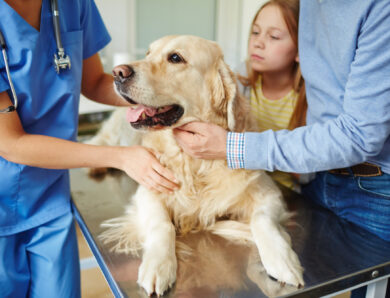
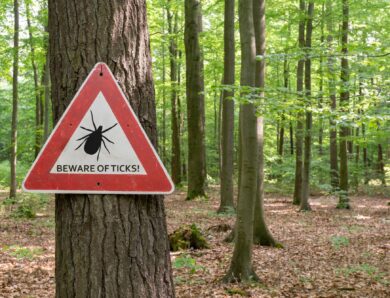

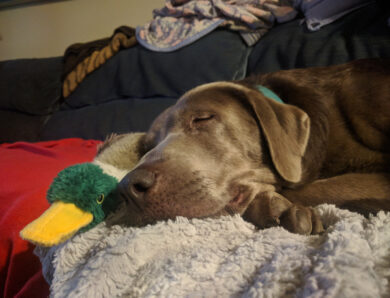


Very interesting 🧐
Very informative
I just got a puppy and Deb is the best. I take her advice on everything. Very good information Deb.